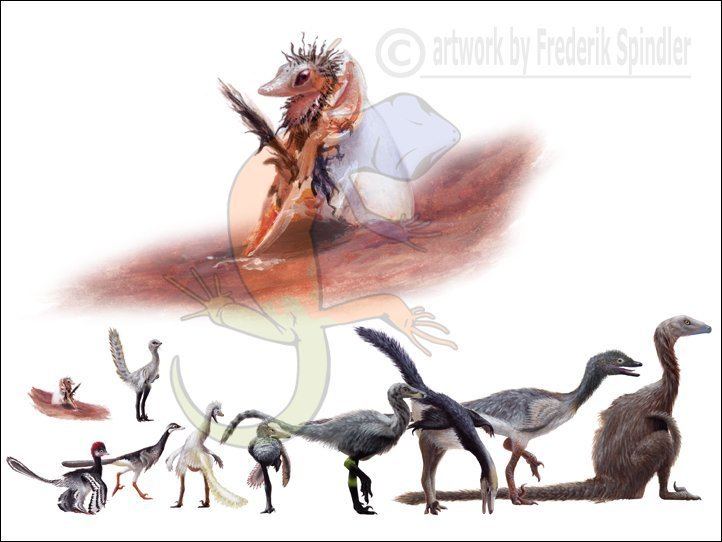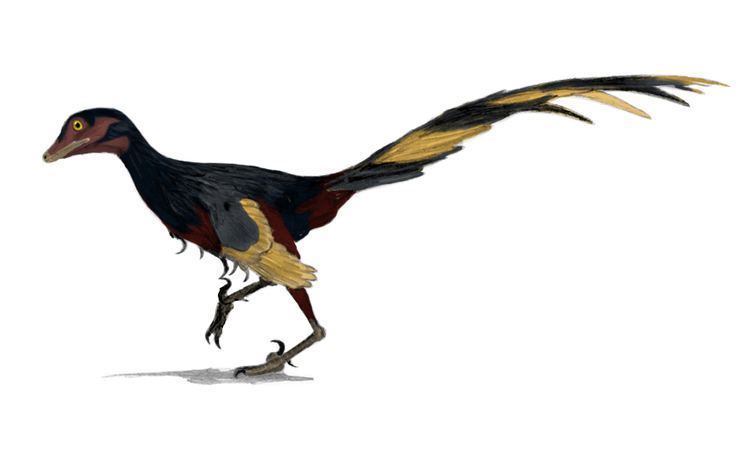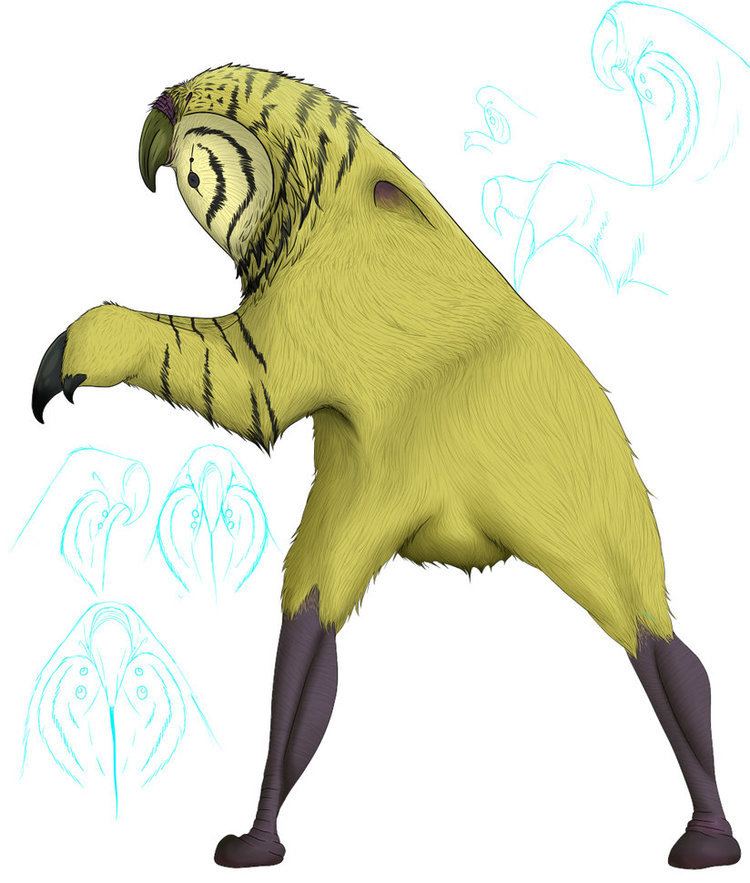Clade Dinosauria Scientific name Troodontidae Rank Family | Phylum Chordata Clade Averaptora Higher classification Saurischia | |
 | ||
Lower classifications Troodon, Saurornithoides, Mei | ||
Troodontidae is a family of bird-like theropod dinosaurs. During most of the 20th century, troodontid fossils were few and scrappy and they have therefore been allied, at various times, with many dinosaurian lineages. More recent fossil discoveries of complete and articulated specimens (including specimens which preserve feathers, eggs and embryos, and complete juveniles), have helped to increase understanding about this group. Anatomical studies, particularly studies of the most primitive troodontids, like Sinovenator, demonstrate striking anatomical similarities with Archaeopteryx and primitive dromaeosaurids, and demonstrate that they are relatives comprising a clade called Paraves.
Contents
- Physical characteristics
- Paleobiology
- Troodontids and bird evolution
- Classification
- Relationships
- References

Physical characteristics

Troodontids are a group of small, bird-like, gracile maniraptorans. All troodontids have unique features of the skull, such as large numbers of closely spaced teeth in the lower jaw. Troodontids have sickle-claws and raptorial hands, and some of the highest non-avian encephalization quotients, suggesting that they were behaviourally advanced and had keen senses. The largest troodontid was Troodon, and the smallest was Anchiornis, which is also the smallest known non-avian dinosaur. They had unusually long legs compared to other theropods, with a large, curved claw on their retractable second toes, similar to the "sickle-claw" of the dromaeosaurids. However, the sickle-claws of troodontids were not as large or recurved as in their relatives, and in some instances could not be held off the ground and "retracted" to the same degree. In at least one troodontid, Borogovia, the second toe could not be held far off the ground at all and the claw was straight, not curved or sickle-like.

Troodontids had unusually large brains among dinosaurs, comparable to those of living flightless birds. Their eyes were also large, and pointed forward, indicating that they had good binocular vision. The ears of troodontids were also unusual among theropods, having enlarged middle ear cavities, indicating acute hearing ability. The placement of this cavity near the eardrum may have aided in the detection of low-frequency sounds. In some troodontids, ears were also asymmetrical, with one ear placed higher on the skull than the other, a feature shared only with some owls. The specialization of the ears may indicate that troodontids hunted in a manner similar to owls, using their hearing to locate small prey.

Although most paleontologists believe that they were predatory carnivores, the many small, coarsely serrated teeth, large denticle size, and U-shaped jaws of some species (particularly Troodon) suggest that some species may have been omnivorous or herbivorous. Some suggest that the large denticle size is reminiscent of the teeth of extant iguanine lizards. In contrast, a few species, such as Byronosaurus, had large numbers of needle-like teeth, which seem best-suited for picking up small prey, such as birds, lizards and small mammals. Other morphological characteristics of the teeth, such as the detailed form of the denticles and the presence of blood grooves, also seem to indicate carnivory. Though little is known directly about the predatory behavior of troodontids, Fowler and colleagues theorize that the longer legs and smaller sickle claws (as compared to dromaeosaurids) indicates a more cursorial lifestyle, though the study indicates that troodontids were still likely to have used the unguals for prey manipulation. The proportions of the metatarsals, tarsals and unguals of troodontids appear indicative of their having nimbler, but weaker feet, perhaps better adapted for capturing and subduing smaller prey. This suggests an ecological separation from the slower but more powerful Dromaeosauridae.
Paleobiology

Many troodontid nests, including eggs that contain fossilized embryos, have been described. Hypotheses about troodontid reproduction have been developed from this evidence (see Troodon).
A few troodont fossils, including specimens of Mei and Sinornithoides, demonstrate that these animals roosted like birds, with their heads tucked under their forelimbs. These fossils, as well as numerous skeletal similarities to birds and related feathered dinosaurs, support the idea that troodontids probably bore a bird-like feathered coat. The discovery of several fully feathered, primitive troodontids (Jinfengopteryx and Anchiornis) lend support to this.
In 2004, Mark Norell and colleagues described two partial troodontid skulls (specimen numbers IGM 100/972 and IGM 100/974) found in a nest of oviraptorid eggs in the Djadokhta Formation of Mongolia. The nest is quite certainly that of an oviraptorosaur, since an oviraptorid embryo is still preserved inside one of the eggs. The two partial troodontid skulls were first described by Norell et al. (1994) as dromaeosaurids, but reassigned to the troodontid Byronosaurus after further study. The troodontids were either hatchlings or embryos, and fragments of eggshell are adhered to them although it seems to be oviraptorid eggshell. The presence of tiny troodontids in an oviraptorid nest is an enigma. Hypotheses explaining how they came to be there include that they were the prey of the adult oviraptorid, that they were there to prey on oviraptorid hatchlings, or that some troodontids may have been nest parasites.
Troodontids and bird evolution
Troodontids are important in research into the origin of birds because they share many anatomical characters with early birds. Crucially, the substantially complete fossil identified as WDC DML 001 ("Lori") is a troodontid from the Late Jurassic Morrison Formation, close to the time of Archaeopteryx and several troodontid specimens from the Tiaojishan Formation of China (Anchiornis) which are even older. The discovery of these Jurassic troodonts is positive physical evidence that derived deinonychosaurs were present before the time that avians arose, and basal paravians must have evolved much earlier. This fact strongly invalidates the "temporal paradox" cited by the few remaining opponents of the idea that birds are closely related to dinosaurs.
Classification
Troodontid fossils were among the first dinosaur remains described. Initially, Leidy (1856) assumed they were lacertilian (lizards), but, by 1924, they were referred to Dinosauria by Gilmore, who suggested that they were ornithischians and allied them with the pachycephalosaurian Stegoceras in a Troodontidae. It was not until 1945 that C.M. Sternberg recognized Troodontidae as a theropod family. Since 1969, Troodontidae has typically been allied with Dromaeosauridae, in a clade (natural group) known as Deinonychosauria, but this was by no means a consensus. Holtz (in 1994) erected the clade Bullatosauria, uniting Ornithomimosauria (the "ostrich-dinosaurs") and Troodontidae, on the basis of characteristics including, among others, an inflated braincase (parabasisphenoid) and a long, low opening in the upper jaw (the maxillary fenestra). Features of the pelvis also suggested they were less advanced than dromaeosaurids. New discoveries of primitive troodontids from China (such as Sinovenator and Mei), however, display strong similarities between Troodontidae, Dromaeosauridae and the primitive bird Archaeopteryx, and most paleontologists, including Holtz, now consider troodontids to be much more closely related to birds than they are to ornithomimosaurs, causing the clade Bullatosauria to be abandoned.
One study of theropod systematics by members of the Theropod Working Group has uncovered striking similarities among the most basal dromaeosaurids, troodontids, and Archaeopteryx. This clade is together called Paraves by Novas and Pol. The cladogram published in Hwang et al. found that Archaeopteryx represents a more basal branch of Paraves, and places dromaeosaurids and troodontids as more derived. This raises the possibility that aerodynamic behaviors could be ancestral to all of Deinonychosauria. The extensive cladistic analysis conducted by Turner et al. (2012) supported the monophyly of Troodontidae.
Relationships
There are multiple possibilities of the genera included in Troodontidae as well as how they are related. Very primitive species, such as Anchiornis huxleyi, have alternately been found to be early troodontids or early members of the closely related group avilalae by various studies. The cladogram below follows the results of a study by Pascal Godefroit and colleagues in 2013.
In 2014, Brusatte, Lloyd, Wang and Norell published an analysis on Coelurosauria, a simplified version shown below. This analysis included more troodontid species but failed to resolve many of their interrelationships, resulting in large "polytomies" (sets of species where the branching order in the family tree is uncertain).
